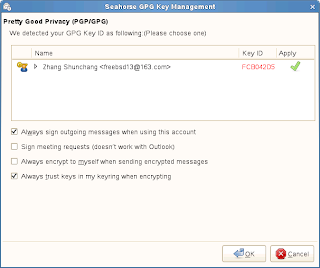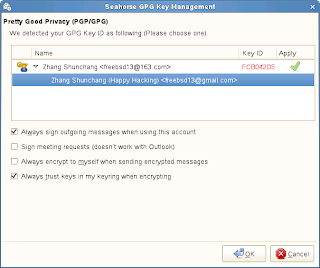hi,
This week i did no/few coding at all, but i have done some research and thought a lot about my project.
The project is implementing a E-Plugin for Evolution to manage the certificates and sign/encryption of message, using Seahorse.
My mentor give me some pointers and intrductions, which is clear and useful. The main step of this project is:
a.Implementation of camel-certdb.h in evolution-data-server's trunk/camel.(but my codes will not planted here)
b.Drawing the UI of certificate management, using the implementation of camel-certdb.h.
c.Test
Mentor also introduces to me a Spanish developer writes the support for libcst in
Tinymail's camel-lite. Camel-lite is a version of Camel that focuses on mobile uses for Tinymail.
And the libcst is similar to Seahorse.
Camel-lite and its libcst implementation:
https://svn.tinymail.org/svn/tinymail/trunk/libtinymail-camel/camel-lite/camel/camel-certdb-cst.c
https://svn.tinymail.org/svn/tinymail/trunk/libtinymail-camel/camel-lite/camel/camel-certdb.c
https://svn.tinymail.org/svn/tinymail/trunk/libtinymail-camel/camel-lite/camel/camel-certdb.h
Camel upstream and its default own implementation:
http://svn.gnome.org/svn/evolution-data-server/trunk/camel/camel-certdb.c
http://svn.gnome.org/svn/evolution-data-server/trunk/camel/camel-certdb.h
Project Progress
-----
Following is my work progress:
1.Some update preparations. ie, svn update to the latest version of Evolution, evolution-data-server, seahorse, configuration. and mess things else. Then i have a new development environment.
2.read the libcst version of manage certificate in Tinymail, as mentioned above.
3.study the Seahorse DBus APIs and write some small code to test and verify.
4.generate a new PGP key pairs(pub key is published on subkeys.pgp.net, UID with my gmail address) and apply for a free certificate from comodo.net, for the future tests.
Next Week Plan
-----
So my next week's plan is to write a camel-certdb-seahorse.c that implements camel-certdb.h, and some other codes necessary.
i am now thingking about my code repository, usually i maintain a subversion repository on one of my lab's server.
Happy Hacking :)
 The next week i will try to introduce the gnome-kering into my project(maybe far away from my original application's goal ? -- integration of the Seahorse), and use it to manage the certificates, mainly about the UI design.
The next week i will try to introduce the gnome-kering into my project(maybe far away from my original application's goal ? -- integration of the Seahorse), and use it to manage the certificates, mainly about the UI design. The next week i will try to introduce the gnome-kering into my project(maybe far away from my original application's goal ? -- integration of the Seahorse), and use it to manage the certificates, mainly about the UI design.
The next week i will try to introduce the gnome-kering into my project(maybe far away from my original application's goal ? -- integration of the Seahorse), and use it to manage the certificates, mainly about the UI design.


 snapshot2: you can select your GPG key from the combobox now:)
snapshot2: you can select your GPG key from the combobox now:) Besides, if you are brave enough, you can try it now:
Besides, if you are brave enough, you can try it now: So, i intend to change it to a combo box, such as:
So, i intend to change it to a combo box, such as: and the private key list in the combo box:
and the private key list in the combo box: The next step. i would like to read the source of evolution trunk about the key input, and integrate my combo box to the evolution.
The next step. i would like to read the source of evolution trunk about the key input, and integrate my combo box to the evolution. Thanks Yang hong, and
Thanks Yang hong, and